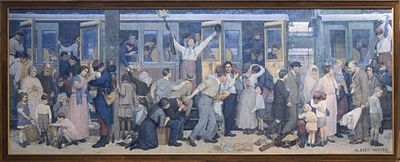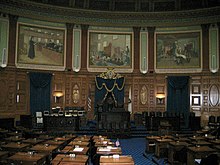Albert Herter
Albert Herter (born March 2, 1871 in New York , † February 15, 1950 in Santa Barbara, California ) was an American painter . He completed his training at the Art Students League of New York and at the Académie Julian and later mainly created murals , still lifes and portraits . In recognition of his work, he was awarded a bronze medal at the Paris World Exhibition in 1900 and was made a member of the National Academy of Design in 1943.
Life
Albert Herter was born in New York in 1871 as the son of German-born designer Christian Herter . His father was a co-owner of the New York-based company Herter Brothers with his half-brother Gustave Herter . Albert Herter received his artistic training first from his father and later at the Art Students League of New York and at the Académie Julian in Paris . There he also met his future wife Adele McGinnis, who came from an American banking family and also studied art there. After getting married in 1893, both lived in Paris from 1894 to 1898 before returning to the United States.
In addition to his own artistic work, Albert Herter also taught at the Art Institute of Chicago . Due to his heritage and the origin of his wife, the couple was able to lead a prosperous life, and his father's work for wealthy families also gave him access to appropriate social circles. From the turn of the century, he and his wife usually spent summers at a property known as The Creeks in East Hampton , Long Island , while they lived in Santa Barbara , California for the rest of the year . After the death of Albert Herter's mother in 1914, they had the property there converted into a luxury hotel called El Mirasol ; after it was sold to a new owner, it was mainly used as a retirement home for wealthy people from the 1920s.
Albert Herter was the father of two sons and a daughter. He died of a heart attack in Santa Barbara in 1950 , four years after his wife's death on The Creeks . Her son Christian Herter was Governor of the US state of Massachusetts from 1953 to 1956 and Secretary of State of the United States from 1959 to 1961 . The family estate in East Hampton was sold to the painter Alfonso Ossorio a year after Albert Herter's death .
Act
Albert Herter's best-known works include various wall paintings, such as “Le Départ des poilus, août 1914” from 1926, which he donated to France . It shows the farewell to soldiers at Paris' Ostbahnhof , where it is located, and is dedicated to his older son Everit, who volunteered for army service after the outbreak of World War I and died in 1918. A series of five wall paintings from 1942 under the title “Milestones on the Road to Freedom in Massachusetts” in the Massachusetts State House in Boston is dedicated to his son Christian. More of his murals, particularly on events in American history , can be found in the headquarters of the National Academy of Sciences in Washington, DC , in the Connecticut Supreme Court building in Hartford and in the Wisconsin State Capitol in Madison .
In addition to wall painting, Albert Herter also created still lifes , especially floral motifs , and took on commissioned portraits . He also worked as an illustrator and designed posters for various organizations such as the American Red Cross and the YMCA during the First World War . His works are exhibited in the Metropolitan Museum of Art , the Museum of Modern Art , the Brooklyn Museum , the Smithsonian American Art Museum , the collection of the National Academy of Design and the art museums of Harvard University .
Awards
In recognition of his artistic work, Albert Herter received an honorable mention at the Salon de Paris in 1890 and a bronze medal at the Paris World Exhibition in 1900 . In addition, he was an Associate ( ANA ) from 1906 and a member ( NA ) of the National Academy of Design from 1943 .
literature
- Albert Herter, 78, Noted as a Muralist. Obituary in: The New York Times . Edition of February 16, 1950, p. 23
- Albert Herter. In: David B. Dearinger: Paintings and Sculpture in the Collection of the National Academy of Design. Volume 1 (1826-1925). Hudson Hills Press, New York and Manchester 2004, ISBN 1-55595-029-9 , p. 266
Web links
- The House of Herter Art (English)
- Archives of American Art: Adele McGinnis Herter and Albert Herter papers, 1882–1946 (English)
- Matthew D. Innis: Random Inspiration : Albert Herter (1871–1950). (No longer available online.) Archived from the original on April 23, 2012 ; accessed on December 12, 2019 . (with images of various works)
- nationalacademy.org: Albert Herter (1871–1950) , short biography (English)
Individual evidence
- ^ Nationalacademy.org: Past Academicians "H" / Herter, Albert NA 1943 ( Memento from April 2, 2015 in the Internet Archive )
| personal data | |
|---|---|
| SURNAME | Herter, Albert |
| BRIEF DESCRIPTION | American painter |
| DATE OF BIRTH | March 2, 1871 |
| PLACE OF BIRTH | New York City |
| DATE OF DEATH | February 15, 1950 |
| Place of death | Santa Barbara (California) |



